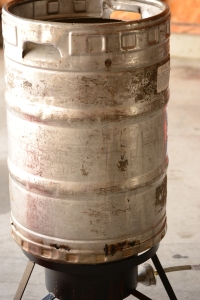The past month has been a very exciting one for me! I have upgraded to all-grain equipment, bought a couple of kegs and a kegerator with a tower and tap on it, kegged my first beer(actually it’s a hard apple cider that I made recently), and brewed my first all-grain batch of awesomeness!
Allow me to reminisce a bit and explain what’s changed.
I started with a basic equipment kit and prepackaged extract recipe kits from NorthernBrewer.com(awesome company with incredible customer service). Initially, I brewed a beer concentrate of about 2 1/2 to 3 gallons on my kitchen stove in a 20 quart stockpot(the keg pictured above has been fashioned into a brew kettle, aka keggle, and has a 15 1/2 gallon capacity!).
“Extract” brewing is perfect for beginners. It can be as basic as adding yeast to a completely pre-made wort(unfermented beer), or be as complex as the “Partial-Mash” technique. Either way, it typically involves the work of extracting the fermentable sugars from the grains done for you in the form of a concentrated malt syrup or dried malt. You boil the concentrate in water along with hops, pitch the yeast, ferment, then bottle. I would recommend this method to anyone, but you are a bit limited in terms of variety of ingredients and control over the final product. The grains that were chosen for that malt extract syrup you are looking at are all that you get.


 “All-grain” brewing, on the other hand, includes the mashing of your own grains(extracting the sugars), sparging the grains(basically rinsing leftover sugars out), a process called “Vorlaufing”(which is just as much fun to do as it is to say),
“All-grain” brewing, on the other hand, includes the mashing of your own grains(extracting the sugars), sparging the grains(basically rinsing leftover sugars out), a process called “Vorlaufing”(which is just as much fun to do as it is to say),
and then continuing on with the same boiling, fermenting, and bottling as before. All-grain is more advanced and much more time-consuming but it’s what the pros do, and it’s what you get in your favorite bottle of local craft beer!
Now that I’ve effectively bored you to death with the brewing jargon, let me give you the goods. Here is what I came up with for my first all-grain recipe which is an Imperial India Pale Ale;
Maiden IIPA
Grain Bill;
11 lbs. Pale Malt 2-row
1 lb. Vienna Malt
1 lb. Carapils
1 lb. Caramel/Crystal 20L (L is for Lovibond, the measure of color you get from your grains)
Hops;
1 oz. Chinook (60 minutes)
1 oz. Chinook (20 minutes)
1/2 oz. Cascade (10 minutes)
1/2 oz. Cascade (5 minutes)
1 oz. Cascade (Dry Hop 7 days)
Yeast and other;
1 Wyeast American Ale II yeast (with a 500 ml yeast starter for 24 hours)
1 tsp. Irish Moss (added 10 minutes from the end of the boil for clarity in the final beer)
Notes on the batch; The minutes next to each hop addition refer to the end of the boil. For example, I boiled this beer for 90 minutes, so I didn’t make my first hop addition until 30 minutes later, or 60 minutes from the end of the boil.
Dry-Hopping is simply adding hops directly to the carboy(vessel the beer is fermented in). Dry-hopping adds aroma without bitterness.
A yeast starter involves boiling 1/2 cup of Dried Malt Extract(DME) in water for 10 minutes and pitching the yeast into that to sit for 24 hours before you add it to your beer.
Well, that’s my first experience with all-grain brewing. The easy part is done. The hard part is waiting.



